Managers often find themselves walking the tightrope of fostering creativity while ensuring continuous productivity.
Amid the broad spectrum of problem-solving approaches, convergent thinking emerges as a focused way of completing tasks. Teams can use it to streamline their decision-making and drive tasks to a fruitful completion.
In this article, we explain what convergent thinking is, some examples of this approach, and when to use convergent vs. divergent thinking in the workplace.
What is convergent thinking?
Convergent thinking focuses on coming up with a single, correct solution to a problem or answer to a question. It involves evaluating various possibilities and applying established rules and logical reasoning to converge on a single correct answer or the best possible solution.
Convergent thinking transforms abstract brainstorming into tangible results, cutting through the haze of indecision that often surrounds dynamic team environments.
What does convergent thinking involve?
Let’s look at some of the key elements of convergent thinking to fully understand how it works.
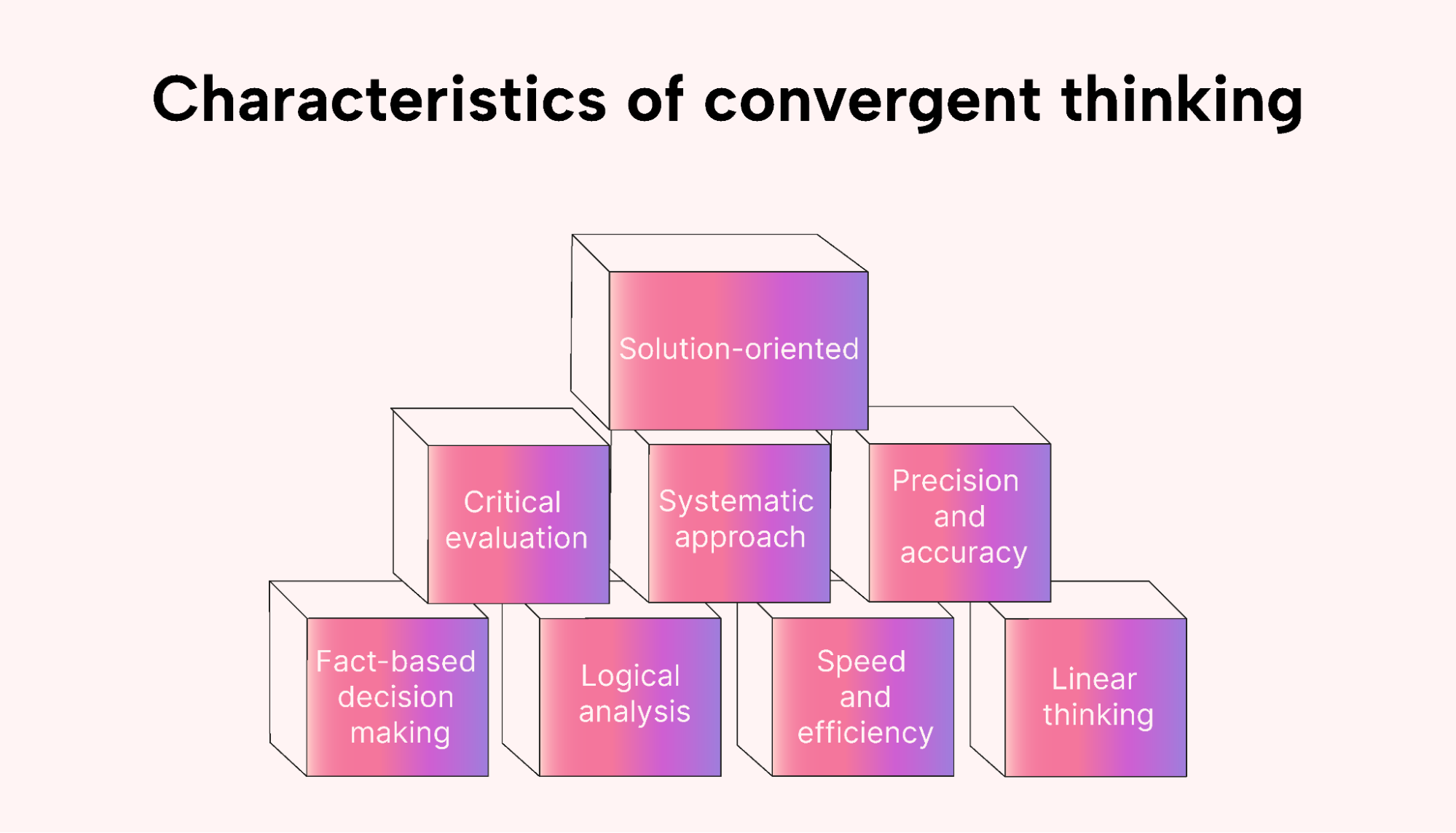 |
Key characteristics of convergent thinking include the following:
Logical analysis: Convergent thinking heavily relies on structured reasoning, where each step follows logically from the last. This logical analysis ensures that conclusions are grounded in a solid foundation.
Critical evaluation: This characteristic involves rigorously scrutinizing ideas or solutions, sifting out flaws and weaknesses to retain only the most viable options.
Systematic approach: Convergent thinkers organize their thought processes in a methodical manner. They progress through problems in a sequential order, ensuring no stone is left unturned.
Precision and accuracy: Convergent thinking emphasizes pinpoint accuracy. The goal is to derive solutions that are both exact and free from errors.
Fact-based decision-making: Rather than relying on intuition or guesswork, convergent thinkers prioritize factual information and empirical evidence when making decisions.
Solution-oriented: The primary focus of convergent thinking is to find definitive solutions to problems. It’s not about exploring every possible route but identifying the most direct path to a resolution.
Speed and efficiency: With its clear focus on the end goal, convergent thinking encourages swift decision-making. This ensures that problems are addressed efficiently, without unnecessary detours.
Linear thinking: Convergent thinkers often process information and derive solutions in a step-by-step manner, ensuring both clarity and consistency.
Convergent thinking vs. divergent thinking
Convergent and divergent thinking represent two distinct approaches to problem-solving and creativity.
While convergent thinking narrows down multiple inputs into a single, optimal solution, divergent thinking involves exploring multiple possible solutions.
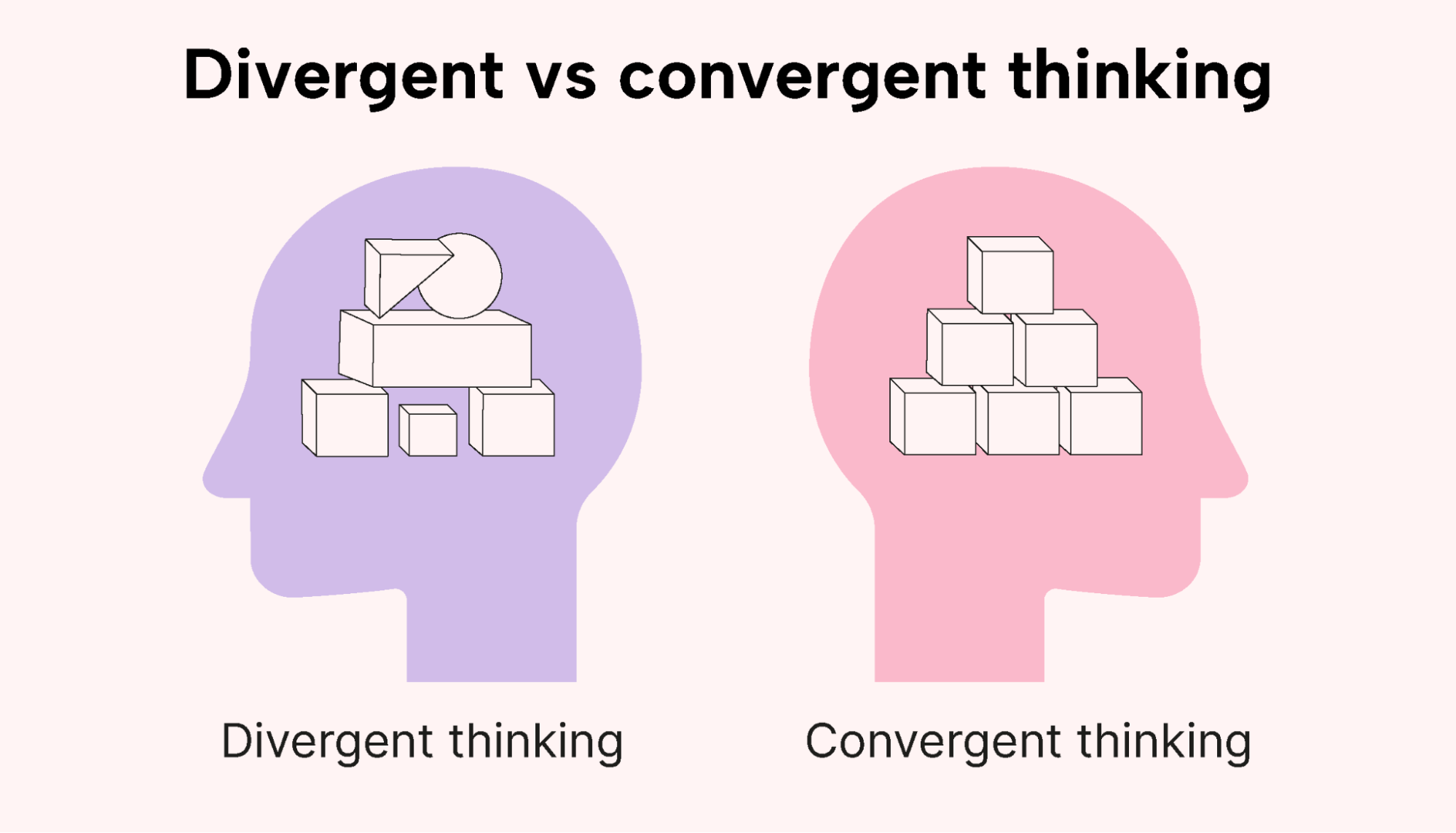 |
Let’s take a closer look at these two types of thinking and how they compare.
Definition
Convergent thinking: Aims to find a single, correct solution to problems.
Divergent thinking: Aims to generate multiple, varied solutions or ideas to problems.
Process
Convergent thinking: Follows a logical, step-by-step process to arrive at a solution.
Divergent thinking: Encourages a spontaneous, free-flowing approach to generate ideas.
Goal orientation
Convergent thinking: Solution-oriented, with a focus on arriving at the most accurate or efficient solution.
Divergent thinking: Idea-oriented, with a focus on exploring many possible solutions or new perspectives.
Evaluation
Convergent thinking: Involves critical evaluation and analysis to select the best possible solution.
Divergent thinking: Suspends judgment to allow for a wide range of ideas to surface.
Creativity
Convergent thinking: Less emphasis on creativity and more on logical and analytical thinking.
Divergent thinking: Encourages creativity, imagination, and original thought.
Structured vs. free-form
Convergent thinking: More structured and systematic in its approach.
Divergent thinking: More free-form and less structured in its approach.
Timing
Convergent thinking: Often utilized in the latter stages of problem-solving to finalize a solution.
Divergent thinking: Usually employed in the early stages of problem-solving to generate ideas.
Outcome
Convergent thinking: Leads to a single, well-defined solution.
Divergent thinking: Leads to a variety of potential solutions or new insights.
Typical uses
Convergent thinking: Often employed in settings that require precise answers or decisions, such as in mathematics, science, or business strategy development.
Divergent thinking: Often used in settings that promote creativity, innovation, and ideation, such as advertising, the artistic field, or the initial phases of project planning.
Imagine brainstorming ways to promote a new product. A team might use divergent thinking to come up with a myriad of ideas, such as online ads, flash mobs, influencer partnerships, or webinars. After listing all of them, the team would use convergent thinking to analyze each option and decide that, based on their target audience and budget, online ads are the most effective strategy.
The convergent thinking process explained
The process of convergent thinking involves a series of structured steps. Here’s a simplified outline of how this methodical process usually unfolds:
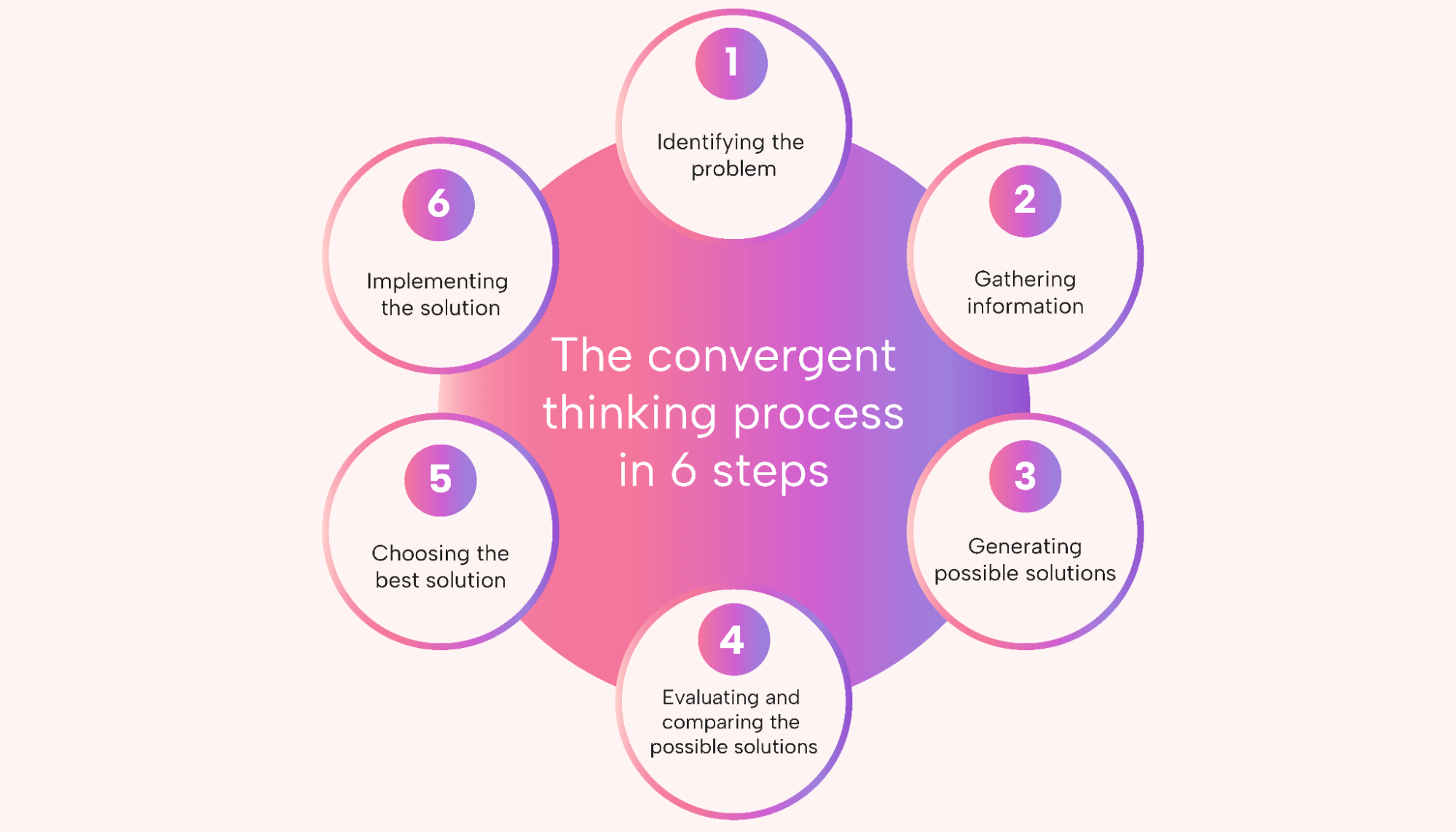 |
1. Identify the problem
This is the stage where you pinpoint and clearly define the issue or challenge you’re facing. Recognizing the problem is the foundation for everything that follows. It ensures that you know exactly what needs to be addressed, avoiding assumptions and misunderstandings.
2. Gather information
Actively seek out relevant data, facts, and insights related to the problem. This could involve researching, consulting experts, or even conducting surveys. Having a well-rounded understanding of the problem equips you to tackle it effectively.
3. Generate possible solutions
Brainstorm and come up with as many potential solutions as you can. It’s all about casting a wide net and considering all possibilities. This creative process ensures that you’re not limiting yourself — and it might even lead to innovative solutions you hadn’t initially considered.
4. Evaluate and compare solutions
Weigh all the potential solutions’ pros and cons. Assessing each idea helps you determine which ones are feasible, which are most effective, and which might present new problems. This is crucial for making an informed decision.
5. Choose the best solution
Select the solution that seems to best address the problem at hand. This doesn’t necessarily mean picking the easiest or quickest one — instead, it might mean the one that will be the most effective in the long run.
6. Implement the solution
With your chosen solution in hand, it’s time to put it into action. This involves planning, gathering resources if needed, and executing your plan of action. Monitoring and adjusting the solution as necessary is also part of this step, as it helps ensure that the solution is indeed addressing the problem and bringing about the desired results.
Examples of convergent thinking
Let’s look at some examples of when to use convergent thinking in different scenarios.
Troubleshooting technical issues
Imagine you’re an IT technician, and a user reports that their computer won’t start. Instead of immediately diving in, you begin by asking questions to isolate the problem. You consider if it’s a hardware or software issue based on the symptoms described. If the computer doesn’t power on, perhaps it’s a faulty power supply. If it starts but doesn’t boot to the operating system, maybe it’s a corrupted hard drive.
 |
Methodically eliminating the possible causes helps you arrive at the most probable source of the problem. At that point, you can take action to fix it.
Choosing a business strategy
A business may have several strategies to choose from, such as expanding its product line, entering a new market, or increasing its online presence. Convergent thinking would involve assessing each strategy’s potential return on investment, the risks involved, any relevant market research data, and the strategy’s alignment with the company’s long-term vision.
Through careful analysis and comparison of these strategies against the company’s objectives and current market conditions, the business can converge on one primary strategy to pursue.
Budget planning
Financial controllers in organizations use convergent thinking when planning budgets. They start with vast amounts of data, including past expenses, future projections, and revenue forecasts. They must then consolidate this data into a coherent budget that aligns with the company’s goals. Decisions have to be made on where to allocate resources.
For instance, if marketing brings in the most revenue, it might get a larger chunk of the budget than the other departments. The final budget is a singular plan that has distilled numerous data points and considerations into a focused financial roadmap.
Product quality control
Quality control in manufacturing involves testing products to ensure they meet specific standards. If a batch of products fails a particular test, convergent thinking is used to determine the cause. Was it a raw material issue? A fault in the machinery? An error in the manufacturing process?
Quality control teams can pinpoint the exact issue by systematically testing each hypothesis and narrowing down the potential causes, ultimately ensuring that the products meet the necessary standards.
Decision-making under specific criteria
Imagine a college admissions officer who must select students for a limited number of slots in a prestigious program. For instance, they might have hundreds of applications but can only accept 50 students.
The officer would start with a broad pool of potential candidates and then begin to narrow down the list based on specific criteria, such as GPA, extracurricular activities, letters of recommendation, and personal essays. With each criterion, the list gets shorter. Convergent thinking is at play here, refining the wide array of options to determine the best group of individuals for the program.
In each of these examples, the process involves sifting through multiple pieces of information or potential solutions and systematically narrowing the focus until the best solution is found or decision is made. This process is the essence of convergent thinking. It’s a methodical, logical approach that, while perhaps not as free-form or creative as divergent thinking, is crucial in situations where a singular, effective solution or decision is required.
Benefits of convergent thinking
The following benefits show why convergent thinking is often the preferred approach in situations that require precise solutions, especially in technical, legal, and financial contexts:
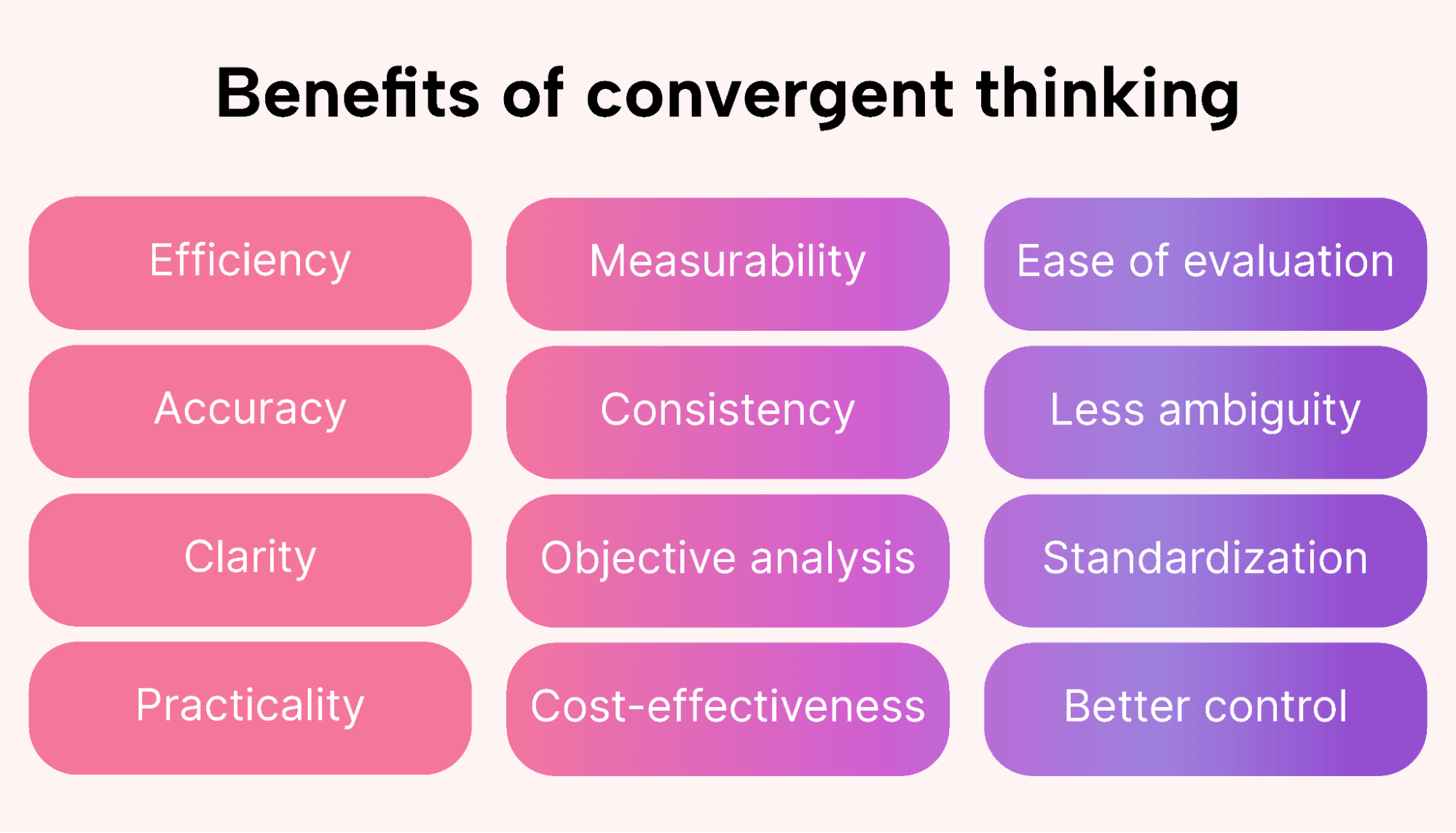 |
- Efficiency: Convergent thinking promotes efficiency, as it directs the focus toward finding the most effective solution in a systematic manner — and often in a shorter amount of time.
- Accuracy: This thinking style emphasizes accuracy and precision, aiming to provide the correct or best possible answer to a given problem.
- Clarity: By narrowing down options and focusing on logical analysis, convergent thinking fosters clarity and a clear direction in problem-solving.
- Practicality: Convergent thinking prioritizes practical solutions by emphasizing logical reasoning. This ensures that the outcome is both functional and feasible.
- Measurability: The outcomes of convergent thinking are usually measurable and quantifiable, making it easier to evaluate its success or effectiveness.
- Consistency: A structured approach leads to more consistent decision-making and problem-solving.
- Objective analysis: Convergent thinking encourages objective analysis based on facts, data, and logic rather than subjective feelings or assumptions.
- Cost-effectiveness: Convergent thinking can be more cost-effective if resources are directed toward arriving at a singular solution.
- Ease of evaluation: Given its structured approach, the processes and outcomes of convergent thinking are easier to evaluate and improve upon over time.
- Less ambiguity: Convergent thinking helps reduce ambiguity by eliminating unlikely or impractical solutions, creating a clearer path toward problem resolution.
- Standardization: Convergent thinking allows for the standardization of processes, which is beneficial in many professional and organizational settings.
- Better control: The systematic approach of convergent thinking provides better control over the problem-solving or decision-making process.
Challenges and criticisms of convergent thinking
While valuable in many scenarios, convergent thinking is not without challenges and criticisms.
Lack of creativity
One of the major criticisms of convergent thinking is that it may stifle creativity. Individuals’ or groups’ focus on finding the single correct or best answer means they might miss out on exploring innovative solutions or creative ideas outside the established boundaries or conventions.
Difficult to use with complex or ambiguous problems
Convergent thinking may fall short when dealing with highly complex, ambiguous, or novel problems in which the “correct” solution isn’t clear or well-defined.
Resistance to change
Convergent thinking may foster a resistance to change or a reluctance to explore new methods or ideas, especially in fast-evolving fields where adaptability is crucial.
Too reliant on logic and analysis
Over-reliance on logical analysis might ignore emotional, ethical, or social considerations that could be important for a well-rounded solution.
Potential for confirmation bias
Convergent thinking can lead to confirmation bias, as individuals or groups may only seek or interpret information in a way that confirms their preexisting beliefs or values — especially when evaluating several possible solutions.
Missed opportunities for learning and growth
Not exploring alternative or unconventional solutions means individuals or groups may miss the opportunities for learning and growth that often come from experimentation and making mistakes.
Possibly less engagement
Convergent thinking can lead to reduced engagement or motivation, especially among those who thrive on creativity, exploration, and discovery.
When to use divergent vs. convergent thinking
Determining when to use convergent or divergent thinking largely depends on the nature of the task or problem at hand, as well as the stage of the problem-solving or creative process you’re in.
Here’s a breakdown of when each of these types of thinking might be more beneficial than the other:
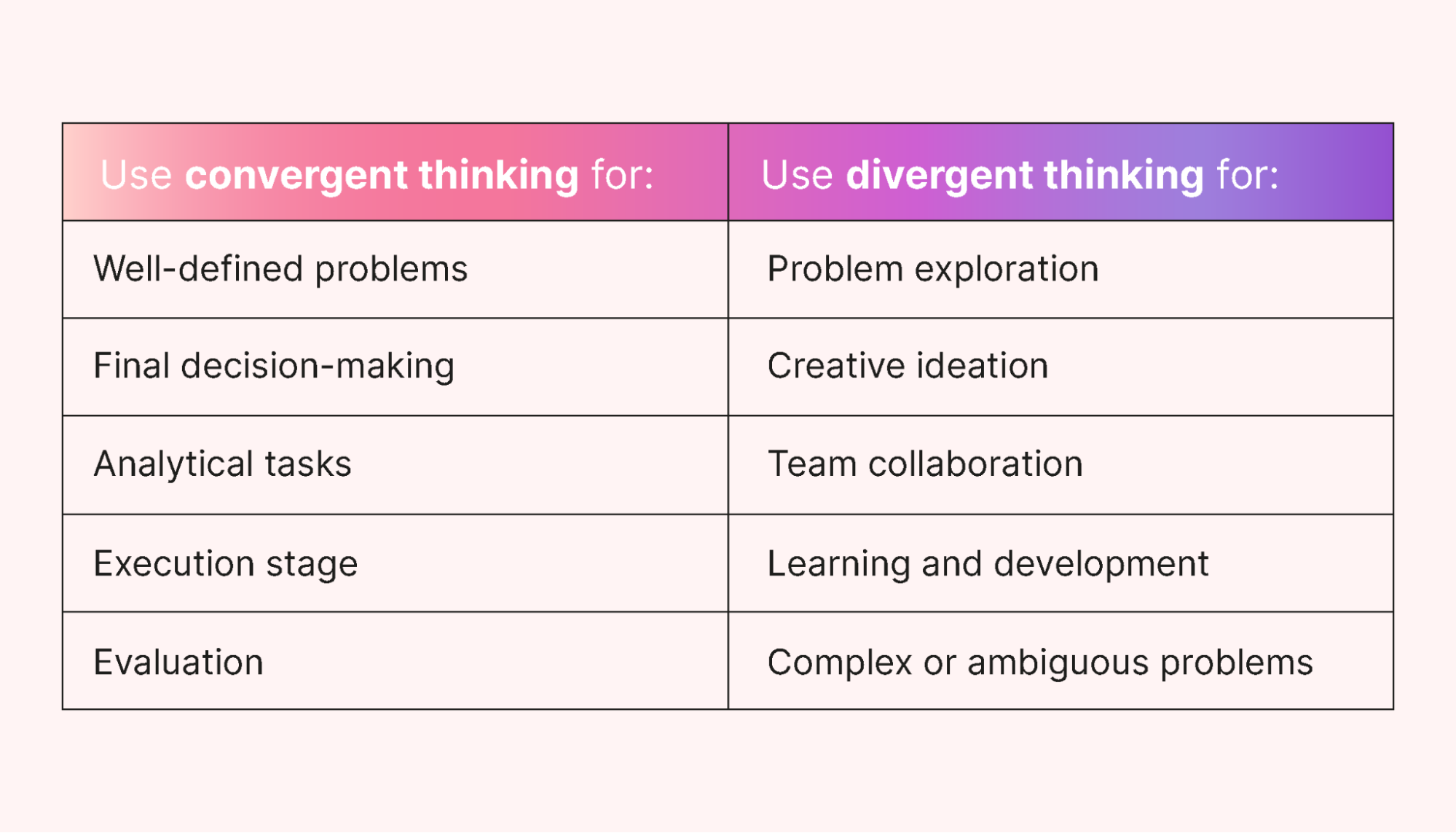 |
Convergent thinking
Use convergent thinking for the following scenarios:
- Well-defined problems
Convergent thinking is often the preferred approach when dealing with problems with a clear or objective solution.
- Final decision-making
When you need to make a decision, especially one based on factual information or specific criteria, convergent thinking can help you analyze your options and select the best one.
- Analytical tasks
Tasks that require data analysis, the evaluation of multiple options against set criteria, or the application of established rules and procedures benefit from a convergent thinking approach.
- Execution stage
When it’s time to implement a solution or execute a plan, convergent thinking helps in focusing efforts and resources efficiently to achieve the desired outcome.
- Evaluation
A convergent thinking approach is often required when assessing the success or effectiveness of solutions, actions, or outcomes as they compare to defined metrics or standards.
Divergent thinking
Use divergent thinking for the following scenarios:
- Problem exploration
In the early stages of tackling a problem, especially a complex or novel one, divergent thinking can help you explore different perspectives and generate a variety of possible solutions.
- Creative ideation
When brainstorming innovative ideas, divergent thinking encourages going outside the box and generating a wide range of options.
- Team collaboration
Divergent thinking can help foster a collaborative environment in which different viewpoints are valued and explored, promoting a more inclusive problem-solving process.
- Learning and development
Encouraging divergent thinking can facilitate learning and personal or professional growth by promoting openness to new experiences and willingness to explore unknown territories.
- Complex, ambiguous, or novel problems
When facing problems for which the solution isn’t clear or well-defined, divergent thinking can help you navigate the ambiguity and discover new or unexpected solutions.
A combination of divergent and convergent thinking is often most effective in real-world scenarios. Start with a divergent thinking phase to explore and generate ideas, and follow it up with a convergent thinking phase to select the best possible solution.
Apply your convergent thinking with Motion
Harnessing the power of convergent thinking becomes significantly easier with tools like Motion. Motion’s streamlined workflow ensures that decision-making is swift, eliminating unnecessary clutter and distractions.
Task management becomes a breeze with Motion, which categorizes and organizes each task to help ensure that you methodically approach each one with clarity and focus.
Don’t let decision fatigue slow you down. Let Motion help by signing up for a free 7-day trial today.





